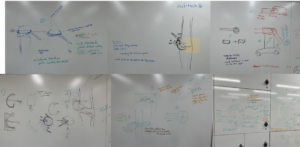Devising a Brainstorming Method
For our concept generation process, we initially tried working individually to devise ideas. This proved to be a subpar method of ideation, as it was not very fruitful. The ideas that emerged during this step of ideation were very similar to each other and were all following a strict set of assumptions. This was limiting us in terms of generation of diverse and unique concepts. At this phase in the process, we knew that the goal should be to generate as many ideas as possible, but we were not sure how to get there. There were a handful of “brainstorming” class periods where we felt stuck in the assumptions about what the device should look like and how it should work. To combat this, the team was tasked with coming to class with a fresh brainstorming idea. Through this task, we agreed upon a team-designed brainstorming method inspired by tips for creative thinking and group brainstorming found online. Our research resulted in a creative, somewhat outlandish, and ultimately largely successful brainstorming session.
Our Brainstorming Process
We split into groups of three on different sides of the room. Each group brainstormed ideas on a whiteboard. We took time in our small groups to draw ideas of what the guide would look like and how it would function. Team members rotated between groups in order to add on to previous ideas and create new ideas with other teammates. At this point we were still largely working from the assumptions that were likely derived from our research, so we took some time to list out these assumptions. These assumptions included that the guide must:
- Specify drill angle
- Specify drill location
- Be handheld
- Be lightweight
- Be safe to use in a medical procedure
- Look like other medical devices/drill guides
- Be adaptable to work on both the left and right legs
Combination and Inversion of Assumptions
After listing these assumptions explicitly, during the next rotation we worked in small groups to combine or invert these assumptions. This involved asking questions like “What if the guide doesn’t need to specify location?” or “What if the handheld criterion and drill location criterion were combined?”. This process resulted in a number of highly creative, outlandish designs which individually had their flaws, but when viewed as a collection we were able to pick and choose the most useful creative ideas from each design and combine them into two promising concepts.

The above image shows the whiteboards after our brainstorming session. Many different ideas emerged from this process, consisted of a myriad of shapes, sizes, and mechanisms. From left to right, top to bottom, these six photos depict brainstorming for 1) a mechanism inspired by current ACLR guides, 2) The two-in-one guide that would later become the Dune prototype, 3) a wheeled stand for holding the knee in place during surgery combned with a drill guide, 4) the stand-alone guide is portrayed in the lower left, 5) an outlandish radial guide design, and 6) a guide intended to denote anatomical landmarks inspired by existing MPFL drill guides.
Brainstorming Process Outcomes
The whiteboard images above illustrate that our brainstorming resulted in many different ideas of what the device could look like and how it could achieve our goal of alleviating tunnel convergence. We covered the whiteboards in sketches and writing to describe how our device could look and function. From our ideation process, two main themes emerged: a stand-alone ALLR drill guide that would be used separately from the ACLR drill guide, and a two-in-one drill guide that aims to work as both an ACLR drill guide and an ALLR drill guide. At this point in the process, we were largely divided. Half of the team wanted to move forward with the stand-alone and the other half was more interested in the two-in-one design. We decided to use this to our advantage and work through both ideas. We separated into three sub-teams in order to develop both of these ideas as well as to develop a testing protocol. The design and fabrication of the Dune and Oasis alpha prototypes soon followed.